If you run a farm or just tend a garden, you know you always have to be on the lookout for harmful insect pests.
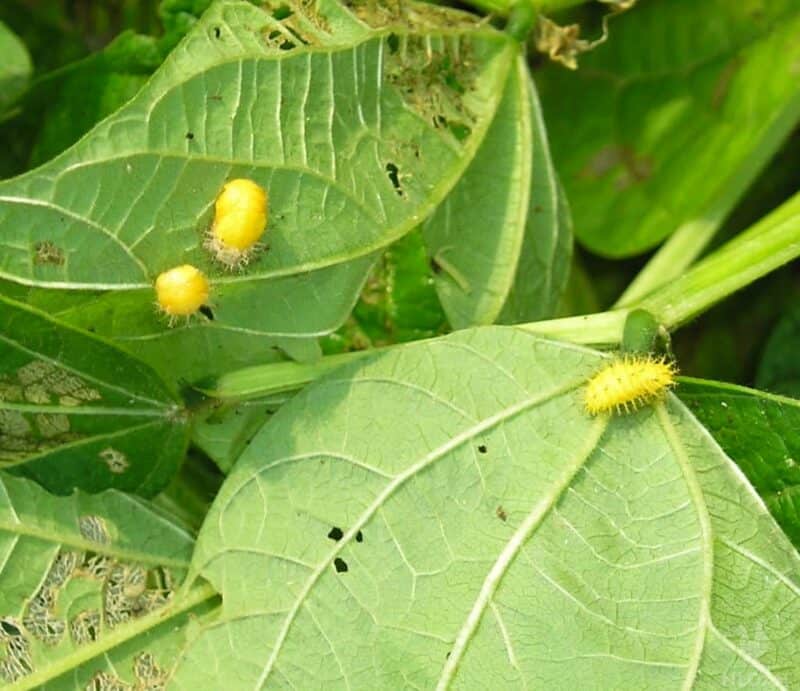
If you live anywhere but in one of the driest climates, you have probably already had a run-in with the Mexican bean beetle, particularly if you grow any sort of bean or other legumes. There are actually good bugs for your garden, but the Mexican bean beetle is not one of them.
These ladybug lookalikes are notorious for the extensive damage they can cause to the leaves of your plants, stunting the growth of crops or even resulting in crop collapse.
Highly successful and with few natural predators in North America, it will be up to you to save your crops from these pests by any means necessary.
Luckily, the task is not impossible. Armed with the right knowledge and a comprehensive plan, it is possible to stamp out Mexican bean beetles before they do too much damage. This article will show you how.
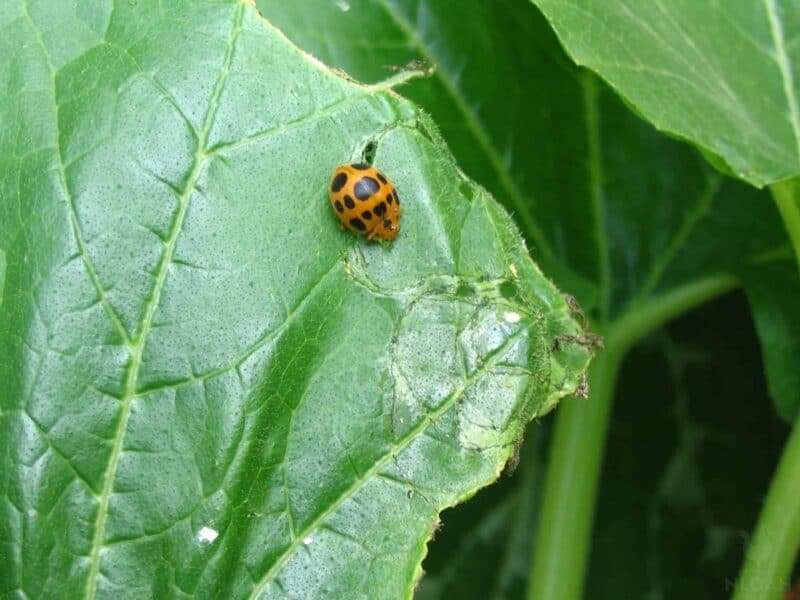
What are We Dealing With? Overview of the Mexican Bean Beetle
The Mexican bean beetle is a small, yellow to brownish-red beetle that is a color-swapped dead ringer for the common ladybug. In fact, the two are close cousins.
Adults grow to about 1/4 inch in length and have 16 black spots on their back covers, totaling 8 per cover in a 3-3-2 pattern. Larval forms are bright yellow, densely spiny caterpillar-looking things.
Originally hailing from somewhere in Mexico’s mountain ranges, the Mexican bean beetle has now spread as far north as Canada and all the way east to the Atlantic seaboard of the United States.
It is particularly common in the Midwest and southeastern states where it has become one of the leading crop pests.
In all phases of life, these bugs eat crops, and that makes them a perennial threat that can be hard to deal with as there is little relief from them once a population gets established in an area.
Luckily, Mexican bean beetles are easy to spot. Both the immature, spiny, larva and the yellow ladybug lookalikes are easy to identify.
However, unlike the helpful ladybug, the Mexican bean beetle feeds on your plants instead of harmful bugs.
They are sort of like infiltrators in that way, and it is easy to miss older adults since they darken with age and are highly likely to blend in with existing genuine ladybug populations.
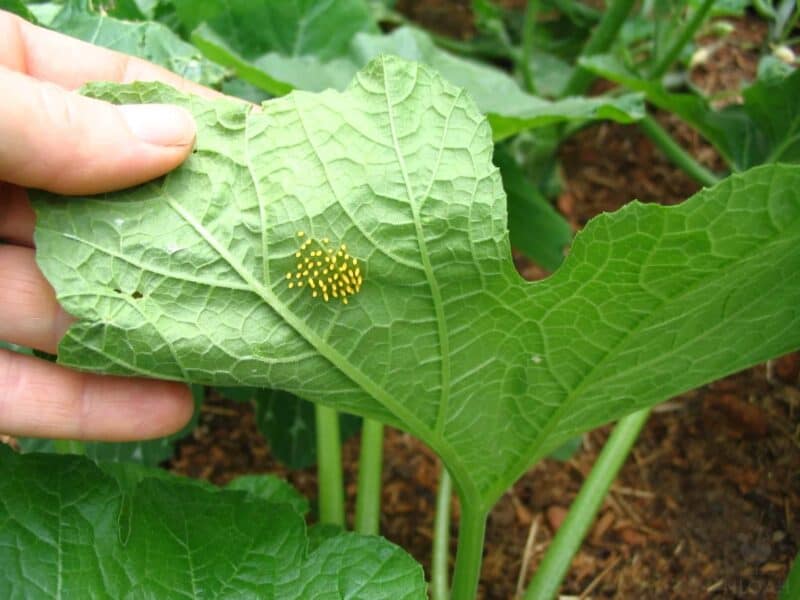
Mexican Bean Beetle Lifecycle
The life cycle of the Mexican bean beetle is simple. Adults emerge from overwintering to mate in late spring or early summer and females lay around 40 to 75 eggs in clutches on the underside of leaves, often near the midrib.
She can repeat this process every couple of days, with each female usually laying several hundred eggs in a season.
In about a week, these eggs hatch into larva which begins to feed voraciously, devouring your plants’ leaves and leaving them with a typical skeletonized or transparent look.
After they fill up on your hard work for a few weeks, these little scumbags will enter their pupal stage prior to hibernating through the approaching winter as fully grown adults. Next year, the cycle repeats.
This rapid reproduction is a large part of why Mexican bean beetles can be such a problem.
Their populations grow exponentially, and they also don’t have many predators in North America.
You might wake up one year to find the county literally crawling with the things. However, this does not mean that they are impossible to control.
Where are these Beetles Found?
Mexican bean beetles can be found everywhere there are crops that are even a little moist. They avoid very dry areas as they cannot survive there.
Chances are that if you raise crops at any scale and live in the Mexican bean beetle’s territory, you have seen them before.
They are a common sight in soybean, lima bean, cowpea, and various other plant fields.
What Kinds of Plants Do Mexican Bean Beetles Target?
The Mexican bean beetle’s preferred food is, unsurprisingly, beans, and other legumes besides.
All sorts of beans are on the menu, including soybeans, lima beans, cowpeas, squash, and various other plants.
Legumes like alfalfa and clover are also popular. They will also eat non-legume plants if they are particularly desperate or if there is nothing else around.
To be clear, these beetles generally prefer to eat leaves off of plants when they can, but they will eat the fruits, i.e. the beans when given a chance.
While the Mexican bean beetle will eat just about any kind of plant listed above they particularly prefer soybeans for some reason.
This might be due to the fact that soybeans are such a common crop, or it might be because they are particularly easy for them to eat. Who knows?
Nonetheless, don’t get lazy just because you don’t grow soybeans; they will happily annihilate all common kinds of bean plants.
How do They Harm Plants?
Mexican bean beetles do damage directly to plants by attacking and eating their leaves. Limited infestations usually do not result in losses, but they can lead to a decrease in yield as well as quality.
The damage that they cause is usually first noticed as small, irregular holes in leaves which later become large and ragged as the population of larva increases.
They prefer to eat the underside of the leaves, which might lead to leaves on plants appearing thin or translucent before the typical, lacy holes appear.
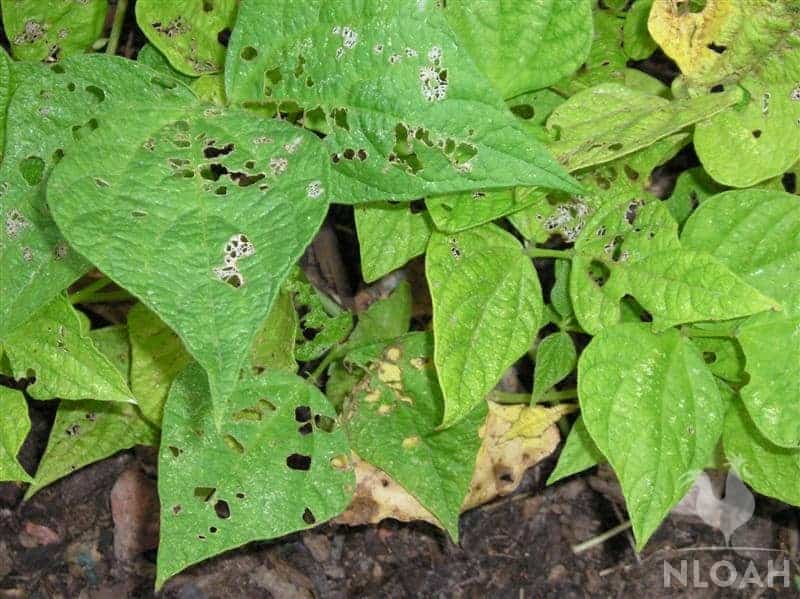
This is bad enough on its own, but it also puts the plant at risk for fungal growth and other problems since the holes in their leaves provide an entry point for molds and other opportunistic organisms.
Another frustrating thing about Mexican bean beetles is that they will often completely strip a plant of its leaves, leaving it withered and dying, and then move right on to the next one.
This can be especially devastating when their numbers are high since they eat with frightening speed.
Worse yet, adults can fly well and larva can hop from one plant to the next when they are planted closely together.
If you don’t get a handle on their numbers, expect to lose some whole crops!
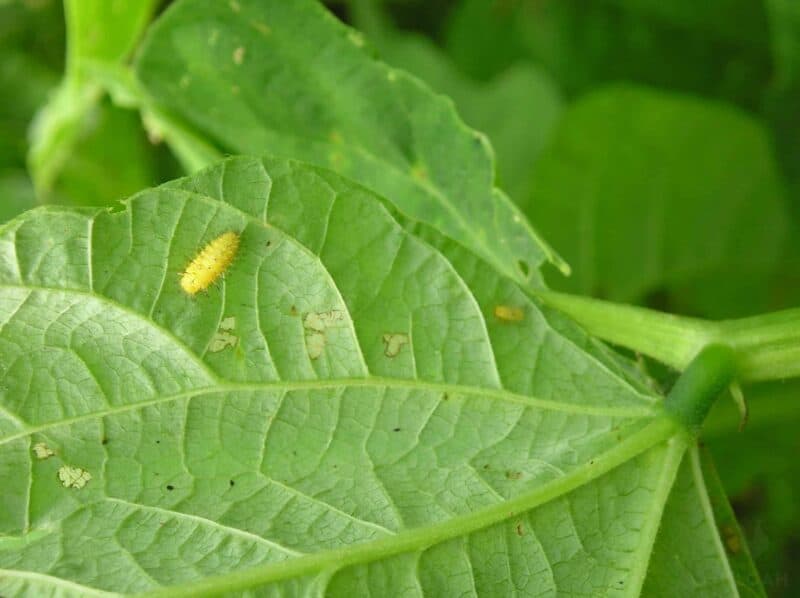
Larvae are Even Worse than Adults!
The single biggest threat associated with these beetles is their young. The adults spread the species but it is the young, spiky larvas that do the lion’s share of the damage.
As might be expected, they attack plants in the same way as adults but with one key difference: they eat way more. A group of larva can strip a plant in no time flat, so you’ll have to stay on constant alert for them.
Additionally, adults will almost always show a preference for leaves and eat them before anything else, but larva will quite happily munch away at flowers, stems, and even fruits.
This makes them especially dangerous to crops since they could directly compromise your fruits.
How Can You Get Rid of Mexican Bean Beetles?
Mexican bean beetles are a pervasive and persistent menace, no doubt about it, so what are we going to do about them?
The good news is you have options, though all of them require you to stay engaged in the task until it is done. You cannot slack on eliminating these buggers or else they will be sure to come back.
Consider the following options and see what will work best for you and your situation.
1. Physical Destruction
The most labor-intensive method is also one of the surest. You will need to go out to your plants and manually remove the beetles as well as their larva.
This means that you need to be on the constant lookout for them since they can lay eggs at any time in the summer.
If you see an adult, simply pick it off of the plant and drop it into a bucket of soapy water. This will kill it and prevent it from flying away or laying eggs.
For larva, you can either squish them or drop them into the soapy water bucket as well; both methods will work just fine.
Make sure to pay close attention to the underside of leaves where adults and larva prefer to congregate and eat.
For modest gardens, this is the best way to go about it as it won’t take too long, is highly effective, and won’t harm plants or other beneficial bugs.
If you have a large planting, this method might be daunting. If you don’t have a small army to help you it will take some time. In any case it is very effective if done correctly.
2. Pesticides
Many common pesticides suitable for protecting crops of all kinds from insect pests work just fine on these beetles. You can use anything from broad-spectrum pesticides to more targeted ones that specifically protect plants from beetles.
As with any pesticide, make sure to follow the directions on the package to the letter. This is important for two reasons:
- You need to make sure that you are using the pesticide correctly or it won’t work as intended
- You don’t want to harm your plants or yourself by using too much of it or not following other critical safety instructions
If you decide to go this route, be aware that it might take a few applications before all of the beetles are gone. This is because they will lay eggs throughout the season and those will hatch, resulting in more beetles.
You will need to apply the pesticide regularly in order to make sure that all of the new beetles are killed before they have a chance to lay eggs themselves.
Pay close attention to the longevity of a given pesticide as you might need to reapply more or less often, particularly after it rains.
The biggest drawback of this method is that, even with targeted formulas, other insects will be killed also. Bees, butterflies, ladybugs, and more will all be likely innocent victims of this method. Whether or not it is worth it is up to you.
3. Chemical Repellents
You might not need to resort to poisoning Mexican bean beetles if you can convince them to steer clear of your plants.
That is where chemical repellents come in. They work by making plants less attractive to the beetles so that they will go elsewhere to eat.
This can be helpful in keeping them from causing too much damage but it will not eliminate them, and they are not 100% effective.
One such repellent is neem oil, which is a natural substance derived from the neem tree. It has been used for centuries in India as an insecticide and has only recently found footing in agriculture as a bug repellent.
Another worthwhile option is kaolin clay, which you can find at many garden stores. It works by coating the leaves of plants, making them less appetizing to bugs and also interfering with their ability to lay eggs.
There are a number of other mild repellents available on the market as well, so do some research and see what will work best for your needs.
4. Predators
One way to control these pests is by encouraging their natural predators to hang around and kill them. This method is often used in commercial agriculture but can be adapted for home gardens as well.
The most common U.S. predators of Mexican bean beetles are green lacewings, ladybugs, and soldier bugs, which are relentless killers of bean beetle larva and eggs alike.
You can encourage these predators to hang out in your garden or field by various means or you can import them directly to your property. Both of these predators are available online or at garden stores as adults and eggs.
You will need to release them into your garden and make sure that they have a food source, which in this case is the Mexican bean beetle.
If you choose to encourage them to come on their own, you can do so by planting things that attract them. Flowering plants will lure ladybugs while alfalfa or sweet alyssum will bring in lacewings.
You can also provide shelter for these predators by leaving some areas of your garden more wild and unkempt than others, as they will appreciate the cover.
One specialized insect that is showing promise is a species of parasitic wasp called Pediobius foveolatus.
These wasps lay their eggs in the larvae of Mexican bean beetles and the resulting larva will consume the beetle from the inside out, killing it.
This method is still being studied but shows a lot of potential for large-scale plantings. You can order these wasps online, and don’t worry; they are tiny and don’t bother people, generally.
If you have a lot of space and time, you might want to consider getting chickens.
These animals are voracious eaters of all kinds of insects, including Mexican bean beetles. They will also help keep your property free of other pests like ticks.
Chickens might be more of a commitment than you want to make in the battle against Mexican bean beetles, but don’t underestimate them!
5. Antagonistic Plantings
Believe it or not, research suggests that there are some living plants that Mexican bean beetles are repulsed by.
Rosemary is one such plant, and it has been shown to be effective at deterring these pests. You can grow rosemary alongside your other plants, or try others in this category like nasturtium, catnip, tansy, and wormwood.
It is best to experiment and see what works for you. You might find that a combination of these plants is sufficient to keep Mexican bean beetles at bay.
6. Trap Crops
A trap crop refers to a sacrificial or decoy planting that is raised specifically to lure pests away from the crops that you want to protect.
In the case of Mexican bean beetles, planting early varieties of beans and other legumes can be effective. These will mature before the main crop and will thus be more available, earlier, to the pests.
The adult beetles will lay their eggs on these plants, and when the larvae hatch, they will have a food source.
Once the early beans are infested and serving as happy homes for adults, eggs, and young alike, you can simply remove them and dispose of them or treat them with pesticide to wipe out entire generations in one shot.
This method is only effective if you have enough space to raise a trap crop without it coming into contact with your main crop. Otherwise, you risk infecting your primary plants as the bugs multiply and spread.
Also, this method obviously requires a lot of effort and coordination, along with precise timing, to be effective.
Consider it a good “firebreak” method for getting rid of an existing population that is plaguing you year after year before you resort to the wholesale deployment of pesticides or other more toxic methods.
7. Coverings
One of the best ways to protect your plants is also the simplest and least invasive. Using row covers or floating row covers is an easy way to exclude adults and eggs from getting to your plants in the first place.
These covers are made of lightweight fabric that will allow sunlight, water, and air to reach your plants but will keep bugs out. You can find them at most garden stores or online.
You will need to remove the coverings periodically to allow pollinators access to your flowers, but other than that, they require very little maintenance. Just make sure that you put them back in place after each opening, so that no new pests have a chance to get in.
As always with these methods, expect a few clever bugs to get in and set up shop. Now protected by the covers setup to keep them out, they will usually thrive, so don’t get lazy; make sure you keep an eye out for telltale damages!
8. Fungal Controls
A clever and somewhat macabre method of controlling Mexican bean beetles is through the use of biowarfare, specifically the deployment of a particular fungal spore that attacks the bugs in their larval stage and slowly debilitates them.
This spore, called Beauveria bassiana, is a naturally occurring fungus that attacks many different kinds of insects. It can be found in soil and on plant leaves, and it is used commercially to control a variety of pests.
You can purchase this fungus online or at some garden stores, and it is relatively easy to apply. Just mix it with water according to the directions and spray it on your plants.
It is most effective when applied to the underside of leaves, where the larvae are likely to be feeding.
The fungus will enter their bodies through any openings, such as spiracles (breathing pores), and begin to grow and multiply inside them, eventually leading to death.
This method is somewhat controversial, as it can kill beneficial insects along with pests, as with pesticides.
However, it is generally less harmful than true pesticide chemicals and has much less risk for you and your animals, so it has some real perks.
If you are in the throes of a major invasion, it may be worth trying this method to see if it can get the population under control.
9. Pre-Season Prevention
Last but not least, don’t forget your pre-season preventative measures. The best way to bust up the bean beetle party is by heavy tilling of the soil.
Adult beetles hibernate in the ground to avoid the bite of winter, so come early spring you can wipe them out before they mate and lay eggs by heavily tilling all surrounding soils to a depth of several inches.
This will expose them to the cold or physically destroy them and that will mean fewer and fewer beetles down the line for every adult you kill.
Don’t Let the Beetles Beat You!
Instead, beat them using these proven techniques above. Mexican bean beetles are persistent pests with a proven tendency to devastate whole crops, but you don’t have to be one of their victims.
With a little bit of effort, you can take back your garden or fields and enjoy the fruits of your labors.
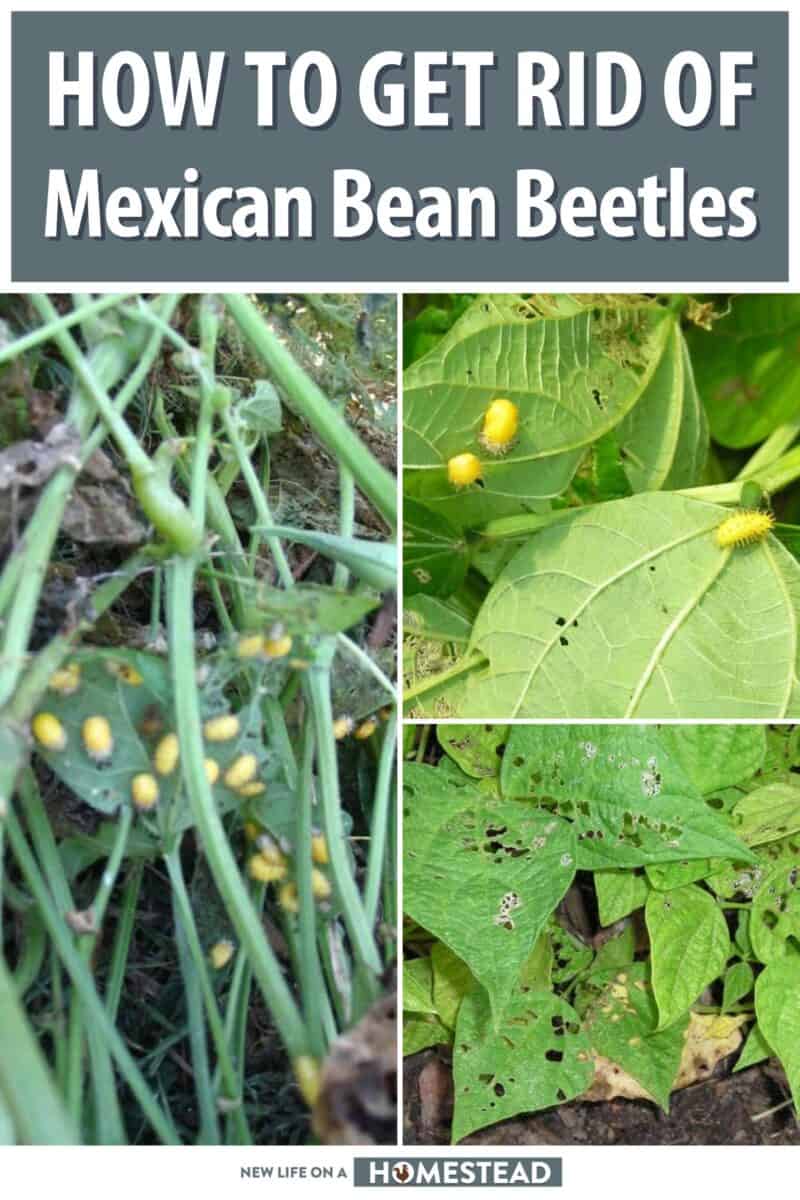
Tom has lived and worked on farms and homesteads from the Carolinas to Kentucky and beyond. He is passionate about helping people prepare for tough times by embracing lifestyles of self-sufficiency.
